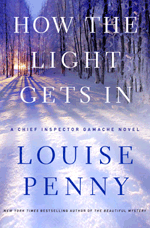I spent the better part of the weekend in bed reading Louise Penny's How the Light Gets In. Most of the other part of the weekend I spent curled up on the sofa or at the kitchen table reading Louise Penny's How the Light Gets In.
I have been reading this series of Chief Inspector Gamache novels out of order. So while some readers gush about the overarching story development, I'm not qualified to comment — I've been exposed to several pieces, but I'm still not seeing the full picture.
However, I'm here to tell you that this novel stands perfectly well on its own. An appreciation of the magical village of Three Pines and its eccentric inhabitants would no doubt be enhanced by having read one or two other novels set here, but I think that would be true no matter what order you read them in.
The case Gamache is on in How the Lights Gets In is related to the death of a quintuplet and delves into a fictionalized historical past inspired by the real-life Dionne Quintuplets. It raises some interesting questions about living life under public scrutiny, the life of celebrity, public versus private, the fabrication of reality for public consumption, the branding and commodification of people.
What non-Quebec readers may not be aware of (and certainly there's been no mention of it in the reviews I've read) is how much the rest of the novel, those supplementary plots that belong to the series-spanning story arc of corruption at high levels, is also based in fact.
This novel starts in the Ville-Marie Tunnel of Montreal. As Audrey drives through, she fears that it, and the city above, may crash down on top of her.
Anyone who lives in Montreal could not but recall the collapse of said tunnel two summers ago. Miraculously no one was hurt, but everyone was afraid.
It is one of the events that led to the establishment of the Charbonneau Commission, an ongoing inquiry into corruption with regard to public construction contracts, implicating organized crime and the mayoralty of Montreal (and other players).
I'd love to know from other readers to what extent you find this aspect of the story — regarding collusion among the powers that be in the Ministry of Transportation and other government departments — believable.
The story of the quintuplet is certainly interesting enough, but it's not as compelling as some of Penny's earlier mysteries. It's thoroughly overshadowed by the other events of the book. The corruption on the force and the mystery as to how far it spreads is by far the stronger storyline in this novel, and I say this without complete knowledge of all that's come before. That is, the novice Penny reader should start with a different book.
Now that Penny is garnering an international reputation, I wish she'd have a little more local recognition for her insightful depiction of life in Montreal and environs.
There's something so perfectly cozy about these cozy mysteries, especially at this time of year. I can see myself reading through the rest of Penny's back catalogue before Christmas. And I'm inspired to get out to the Eastern Townships for a little visit...
(Check out what peril other readers are imbibing this season.)
Sunday, September 08, 2013
Subscribe to:
Post Comments (Atom)




No comments:
Post a Comment